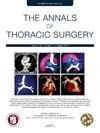Impact of Hospital Transfers on Cardiac Surgery Outcomes: A Society of Thoracic Surgeons Adult Cardiac Surgery Database Analysis
IF 3.6
2区 医学
Q1 CARDIAC & CARDIOVASCULAR SYSTEMS
引用次数: 0
Abstract
Background
Transfers for cardiac surgery are not well studied. We sought to understand the risk profile of transferred patients and determine whether transfer rates vary by cardiac surgery and whether outcomes of transferred patients vary with type of referral hospital/surgery.
Methods
Patients undergoing cardiac surgery with operative risk models were identified from The Society of Thoracic Surgeons database between July 1, 2014, and December 31, 2022. Patients were stratified as no transfer, transferred from hospital with cardiac surgery, and transferred from hospital without cardiac surgery. Risk associated with transfer compared with no transfer was derived by using multivariable logistic regression for operative mortality and select perioperative outcomes.
Results
Included were 1,828,787 patients at 1145 hospitals, with 1,452,491 no-transfer patients (79.4%), 28,862 transfers (1.6%) from hospitals with cardiac surgery, and 347,434 transfers (19.0%) from hospitals without cardiac surgery. Most transferred patients underwent coronary artery bypass grafting (83.6%); however, transfers from hospitals with cardiac surgery were most common for mitral valve replacement (17.9%). Transferred patients had increased comorbid diseases and urgent/emergent procedures. In multivariable analysis, transfers from hospitals with/without cardiac surgery were not associated with differential risk of adverse outcomes by procedure type. Patients transferred from hospitals with cardiac surgery undergoing mitral and aortic valve replacement and coronary artery bypass grafting had significantly lower adjusted mortality risk compared with nontransferred patients, whereas composite morbidity/mortality was higher in mitral valve repair.
Conclusions
Patients transferred for cardiac surgery are generally higher risk; yet, outcomes at transfer to hospitals are as expected or better. However, further research is necessary to examine patients who are transferred but do not undergo surgery.
转院对心脏手术结果的影响:胸外科医师协会成人心脏手术数据库分析》(Society of Thoracic Surgeons Adult Cardiac Surgery Database Analysis)。
背景:有关心脏手术转院的研究并不多。我们试图了解转院患者的风险概况,确定转院率是否因心脏手术而异,以及转院患者的预后是否因转诊医院/手术类型而异:方法:我们从胸外科医师协会数据库中找到了 2014 年 7 月 1 日至 2022 年 12 月 31 日期间接受心脏手术并具有手术风险模型的患者。患者被分层为:未转院、从有心脏手术的医院转院和从无心脏手术的医院转院。通过多变量逻辑回归得出手术死亡率和部分围手术期结果,与未转院相比,转院的风险更大:共纳入了 1,145 家医院的 1,828,787 名患者,其中 1,452,491 名患者未转院(占 79.4%),28,862 名患者转院自进行过心脏手术的医院(占 1.6%),347,434 名患者转院自未进行过心脏手术的医院(占 19.0%)。大多数转院患者都接受了心血管造影术(24.8%),但从进行过心脏手术的医院转院的患者中,二尖瓣置换术最为常见(17.9%)。转院患者的合并症和紧急/急诊手术有所增加。在多变量分析中,从有/无心脏手术的医院转院与不同手术类型的不良后果风险无关。与非转院患者相比,从有心脏外科手术的医院转院接受二尖瓣和主动脉瓣置换术及CABG的患者调整后的死亡率风险明显较低,而二尖瓣修复术的综合发病率/死亡率较高:结论:转院接受心脏手术的患者一般风险较高,但转入医院的治疗效果与预期相符或更好。结论:转院接受心脏手术的患者一般风险较高,但转入医院的治疗效果与预期相符或更好。不过,有必要对转院但未接受手术的患者进行进一步研究。
本文章由计算机程序翻译,如有差异,请以英文原文为准。
求助全文
约1分钟内获得全文
求助全文
来源期刊

Annals of Thoracic Surgery
医学-呼吸系统
CiteScore
6.40
自引率
13.00%
发文量
1235
审稿时长
42 days
期刊介绍:
The mission of The Annals of Thoracic Surgery is to promote scholarship in cardiothoracic surgery patient care, clinical practice, research, education, and policy. As the official journal of two of the largest American associations in its specialty, this leading monthly enjoys outstanding editorial leadership and maintains rigorous selection standards.
The Annals of Thoracic Surgery features:
• Full-length original articles on clinical advances, current surgical methods, and controversial topics and techniques
• New Technology articles
• Case reports
• "How-to-do-it" features
• Reviews of current literature
• Supplements on symposia
• Commentary pieces and correspondence
• CME
• Online-only case reports, "how-to-do-its", and images in cardiothoracic surgery.
An authoritative, clinically oriented, comprehensive resource, The Annals of Thoracic Surgery is committed to providing a place for all thoracic surgeons to relate experiences which will help improve patient care.
 求助内容:
求助内容: 应助结果提醒方式:
应助结果提醒方式:


